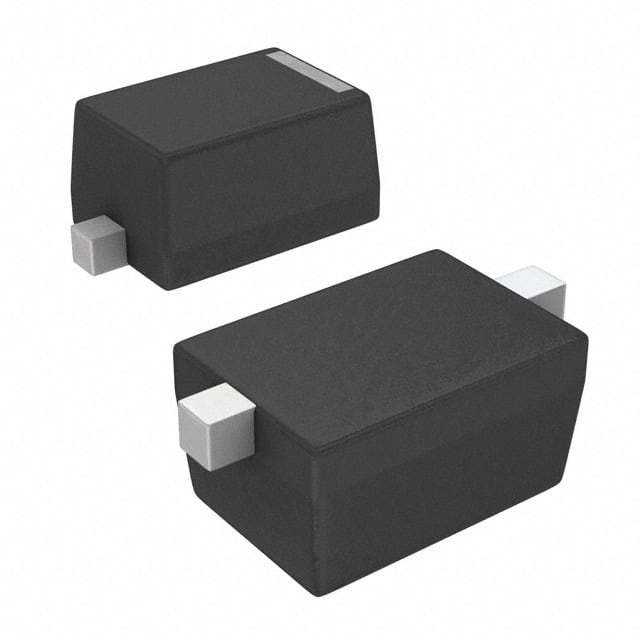1N4448WT Diode
Product Overview
The 1N4448WT diode is a high-speed switching diode that belongs to the semiconductor category. It is commonly used in electronic circuits for various applications due to its fast switching speed and low forward voltage drop. The diode is characterized by its small size, high reliability, and low leakage current. It is typically available in a surface mount package, making it suitable for compact electronic designs.
Basic Information
- Category: Semiconductor
- Use: High-speed switching in electronic circuits
- Characteristics: Fast switching speed, low forward voltage drop, small size, high reliability, low leakage current
- Package: Surface mount
- Essence: Fast and reliable switching performance
- Packaging/Quantity: Typically available in reels or tubes containing multiple units
Specifications
- Maximum Reverse Voltage: 100V
- Average Rectified Current: 150mA
- Forward Voltage Drop: 1V at 10mA
- Reverse Recovery Time: 4ns
- Operating Temperature Range: -65°C to +175°C
Detailed Pin Configuration
The 1N4448WT diode typically has two pins, with one serving as the anode and the other as the cathode. The pinout configuration is as follows: - Anode (A) - Pin 1 - Cathode (K) - Pin 2
Functional Features
- Fast switching speed
- Low forward voltage drop
- Low reverse recovery time
- High reliability
Advantages and Disadvantages
Advantages
- Fast response time
- Low power dissipation
- Small form factor
- High reliability
Disadvantages
- Limited maximum reverse voltage
- Low average rectified current
Working Principles
The 1N4448WT diode operates based on the principles of semiconductor physics. When forward biased, it allows current to flow with minimal voltage drop. In reverse bias, it exhibits fast recovery characteristics, making it suitable for high-speed switching applications.
Detailed Application Field Plans
The 1N4448WT diode finds extensive use in the following application fields: - High-speed switching circuits - Signal demodulation - Overvoltage protection circuits - Clipping and clamping circuits - Voltage multiplier circuits
Detailed and Complete Alternative Models
Some alternative models to the 1N4448WT diode include: - 1N4148: Similar high-speed switching diode with comparable specifications - BAT54S: Schottky diode with fast switching characteristics - BAV99: Dual diode with high-speed switching capabilities
In conclusion, the 1N4448WT diode is a versatile semiconductor component known for its fast switching speed, low forward voltage drop, and high reliability. Its compact size and efficient performance make it well-suited for a wide range of electronic applications.
Word Count: 443
قم بإدراج 10 أسئلة وإجابات شائعة تتعلق بتطبيق 1N4448WT في الحلول التقنية
What is the 1N4448WT diode used for?
- The 1N4448WT diode is commonly used for general-purpose switching and high-speed applications.
What is the maximum forward voltage of the 1N4448WT diode?
- The maximum forward voltage of the 1N4448WT diode is typically around 1V at a forward current of 10mA.
What is the reverse breakdown voltage of the 1N4448WT diode?
- The reverse breakdown voltage of the 1N4448WT diode is typically around 100V.
Can the 1N4448WT diode handle high-frequency applications?
- Yes, the 1N4448WT diode is suitable for high-frequency applications due to its fast switching characteristics.
Is the 1N4448WT diode suitable for use in rectifier circuits?
- Yes, the 1N4448WT diode can be used in rectifier circuits due to its fast recovery time and low forward voltage.
What is the maximum continuous forward current rating of the 1N4448WT diode?
- The maximum continuous forward current rating of the 1N4448WT diode is typically around 250mA.
Does the 1N4448WT diode have a low leakage current?
- Yes, the 1N4448WT diode has a low leakage current, making it suitable for precision applications.
Can the 1N4448WT diode be used in temperature-sensitive applications?
- The 1N4448WT diode has a wide operating temperature range, making it suitable for temperature-sensitive applications.
Is the 1N4448WT diode available in surface mount packages?
- Yes, the 1N4448WT diode is available in surface mount packages, making it suitable for compact designs.
Are there any specific precautions to consider when using the 1N4448WT diode?
- It is important to ensure proper heat dissipation and adhere to the specified maximum ratings to prevent damage to the 1N4448WT diode.


